Deep Dive: The Onion Family
Alliums are central to cooking, from leeks to wild garlic. This guide introduces the incredible variety in this genus and helps with garden planning according to your goals. Recipes at the end!
Note: This guide is long and will most probably be truncated by your email server. Click on “view entire message” or the “…” at the end to view the whole text.
The two goals that drive my choices in the kitchen garden: 1) greatest possible variety and year-round harvest. That might mean the more modest Welsh onions and leeks for winter harvest, during summer more colorful and flavorful red onions and shallots. Over the years, an increasing variety of perennial varieties have found their way into the garden plan and I am constantly trying new varieties.
In the first year of market gardening, ‘Walla Walla’ onions were my big experiment. Could I grow them from seed? Would they get as big as the ones grown in the Pacific Northwest? It worked, except for one thing: They were more pungent than I expected. Where was the sweetness everyone raved about? Later, I learned that the level of sulphur in the soil has an impact on level of pungency, even with varieties that tend to be sweeter thanks to more fructose.
In the meantime, I’ve found a different French variety (‘Walla Walla’ originally came from the French island of Corsica) that I prefer: ‘Blanc Hâtif de Paris’ (white onion of Paris). It is a regional variety that produces large, flat bulbs. Like ‘Walla Walla’, the storage value is relatively low, so it’s best to use them fresh. That said, they have kept well through March for me in temperate, dry storage. ‘Hâtif de Paris’ is a robust, winter-hardy variety that is often recommended for spring harvest, i.e. sowing in fall. I sow them in January as transplants for summer harvest.
The onion family, Allium, is a large genus of over one thousand species, including the decorative late-spring flowers in cottage gardens such as Allium giganteum. Actually, all allium species have beautiful flowers, from the large round heads of leek (Allium ampeloprasum) to the delicate white flowers of garlic chives (Allium tuberosum). Bees and other pollinators love allium blossoms, and in the case of edible varieties make it all the easier to produce viable seed.
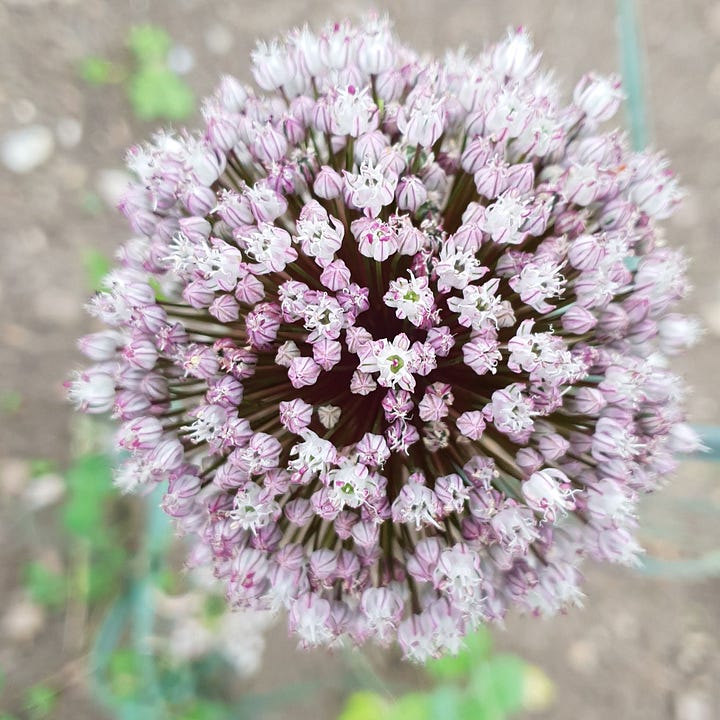
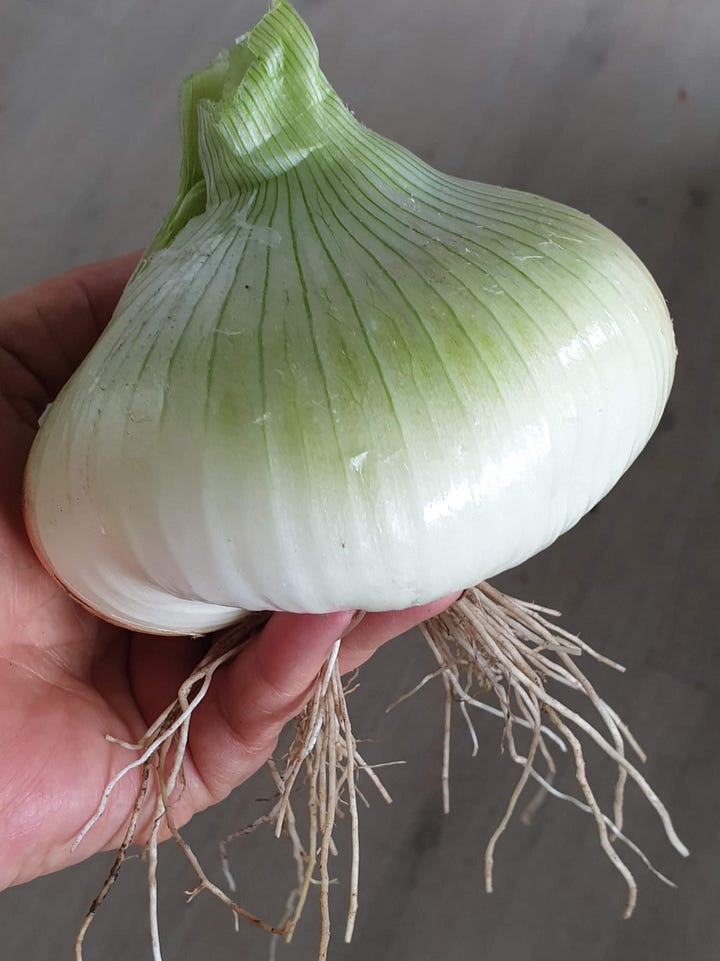
Good to know
A kitchen and therefore a kitchen garden is inconceivable without the onion family. Depending on the species, they are easily propagated with bulbils, seed onions, or seeds. Some types, including spring onions, leeks, and shallots, will multiply vegetatively by building small bulbs around the root base or splitting in their second year. Generally, onions are part of spring planting and sowing, but spring onions can be sown through September in my climate.
Healthy flavors: The sulphur-containing active ingredients in onions and garlic are antioxidative, antiobiotic, and antifungal. They can lower cholesterol and have a positive effect on diabetes and activate the digestive system.
Home remedy: Onions are an old home remedy for reducing cold symptoms. I swear by the classic French onion soup, but in Europe people make onion syrup and onion honey. Onion compresses, warm or cold, are used to reduce inflammation.
Natural fungicide: I have used garlic tea to successfully combat mildew on late-season zucchini leaves. Cut up several cloves and put them in one liter / one quart of water that has just been brought to the boil. Allow to seep. When cool, strain the tea and put in a spray bottle. Spray the tops and bottoms of leaves in the morning.
Good companions: Lettuce, radish, beets, tomatoes, strawberries, savory and dill are all good companions, but the most common companion is carrots. The aroma of onions is said to keep carrot fly at bay. Avoid planting onions or garlic with peas and beans.
Myth buster: I have never given onion seedlings a “haircut” because it doesn’t make sense: The leaves are needed for photosynthesis. The popular practice of trimming the leaves of seedlings will not yield bigger bulbs! All it does is increase efficiency for large-scale growers who don’t want to deal with tangled leaves when planting out and the loss in yield is worth the efficiency for them.
Video tip: More on why trimming isn’t necessary and more is in Farmer Jesse’s podcast about growing onions.
In the kitchen: All parts of alliums are edible, from leaf to root. The blossoms are especially decorative on salads. I also make chive blossom vinegar each year, perfect for dressing salads that benefit from a touch of onion aroma. Leek greens and all allium roots can be dried without losing much of their aroma. I used the dried flowers in herb salts. Wild garlic leaves are also easy to dry and make an excellent garlic salt. Young roots, especially of spring onions, are delicious pickled. The young seed pods of garlic chives are excellent pickled as capers.

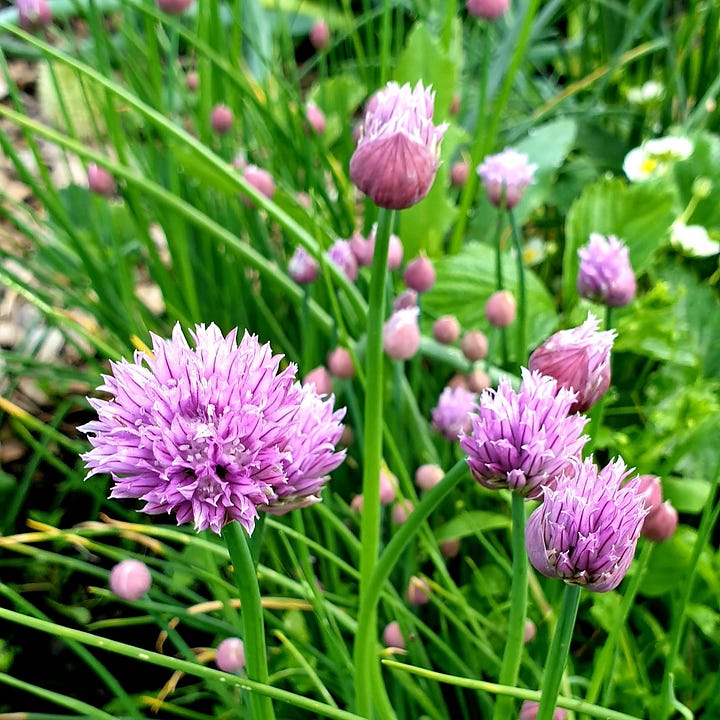
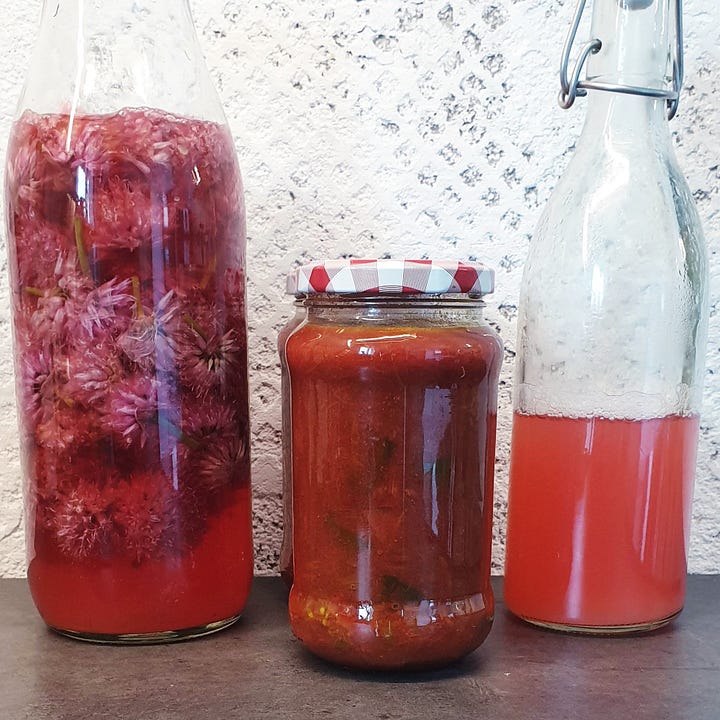

My goal for year-round harvest is possible by including European Welsh onions and leeks in the garden plan. I also grow storage onions and garlic for use in the winter. During the spring and summer, chives and garlic chives provide fresh aroma. Bunching onions are a staple and I sow them three times throughout the season - February as transplants, mid-June for fall, August for late fall. They often serve as a substitute for cooking onions, if my supply has run out.
Spring (bunching) onions
Several different types and varieties are available as bunching onions, and in this case it’s very important to know your Latin names to know what you’re getting. The Asian winter or Welsh onion (Allium fistulosum) ‘Ishikura‘ is popular among vegetable growers, because it can be started in September from seed and overwintered for an earlier spring harvest. Onions of this type are actually perennial, if we treat them that way. In early spring of their second year, they split and double in number. The new onions tend to remain small, however, if space is limited. ‘Freddy’, ‘Ishikura’, and ‘Red Beard’ are my favorites, aside from the heirloom Welsh onion. I grow bunching onions from seed for the first generation, because the young plants are easier to clean. They are also easy to produce seed for.
Other spring onion types are Allium cepa. Although they are botanically the same as bulbing onions, varieties such as ‘Guardsman’ never go beyond developing a small, slightly round bulb. Among the Allium cepa are multi-purpose varieties that can be harvested early as spring onions or later as fully developed cooking onions. ‘Hâtif de Paris’ is one such variety. For gardeners who want to keep it simple, this is a good strategy. Sow them once in spring, harvest the young onions as spring onions and leave the rest to develop fully.
Good to know: When the tips of bunching onions start to yellow, it is definitely time to finish harvesting!
Sowing: 0.5 cm / 1/4 in. deep, pat down well. Ideal soil temp is 15-20° C / 60-60° F, but seeds will germinate relatively well as of 10 Grad. The seeds are relatively hard-shelled, so adequate moisture is important for germination. Starting as transplants is recommendable for getting a head start in early spring or preparing for a late planting while summer vegetables are still occupying garden space.
Spacing: 1-2.5 cm / 1/2-1 in. If they are sown too closely, they are easy to thin and the baby plants can be used like chives, from leaf to root. When I start transplants, I go for 7-10 per cell and plant them in bunches about 20 cm / 8 in. apart, which allows me to harvest a bunch in one go in the market garden.


Bulbing onions
Bulbing onions (Allium cepa) are easy to grow from seed, but because they need a longer growing season it is helpful to start them in February to plant out in spring. Seed onions, small immature onions, can be planted in November for early harvest in July or in April for harvest in November.
Bulbing onions are „photoperiodic“, meaning daylight initiates bulbing. Each variety is categorized: short-day (10-12 hours of daylight), intermediate (12-14 hours), long-day (14-16 hours). If your region has shorter daylight hours in summer, those varieties needing longer will tend to bolt rather than bulb up. This phenomenon can also occur with seed onions that are planted in fall. Some varieties are neutral, meaning that the length of daylight is irrelevant. In Austria, where I live, we have a “long-day zone”; on June 21st, the summer solstice, our daylight is just under 16 hours.
Good to know: Onions are ready to pick when the leaves start to turn yellow and fall to the ground. Before storing them, they should be cured by hanging them in a warm, dry place with good air circulation.
Sowing: Growing from seed is the same as for bunching onions, but the spacing should be 2-3 times greater. I start mine in February as transplants. Seed onions should be planted with the tip facing up and the top third of the bulb above ground.
Spacing: Recommended spacing is 10 cm / 4 in., but it depends on the variety. I plant in groups of three with a spacing of 20 cm / 8 in. between groups. Varieties that develop large bulbs need more space. Onions want to be on the surface, so avoid planting them too deep!
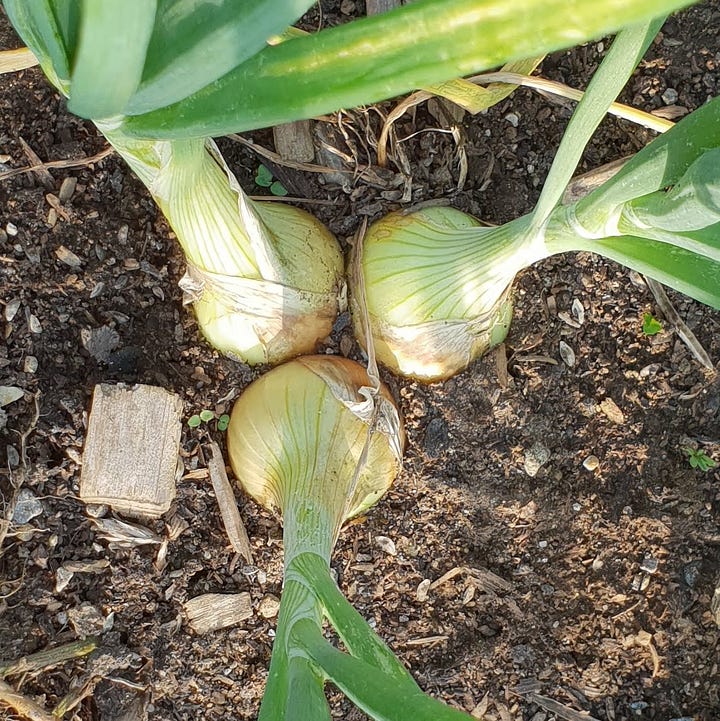
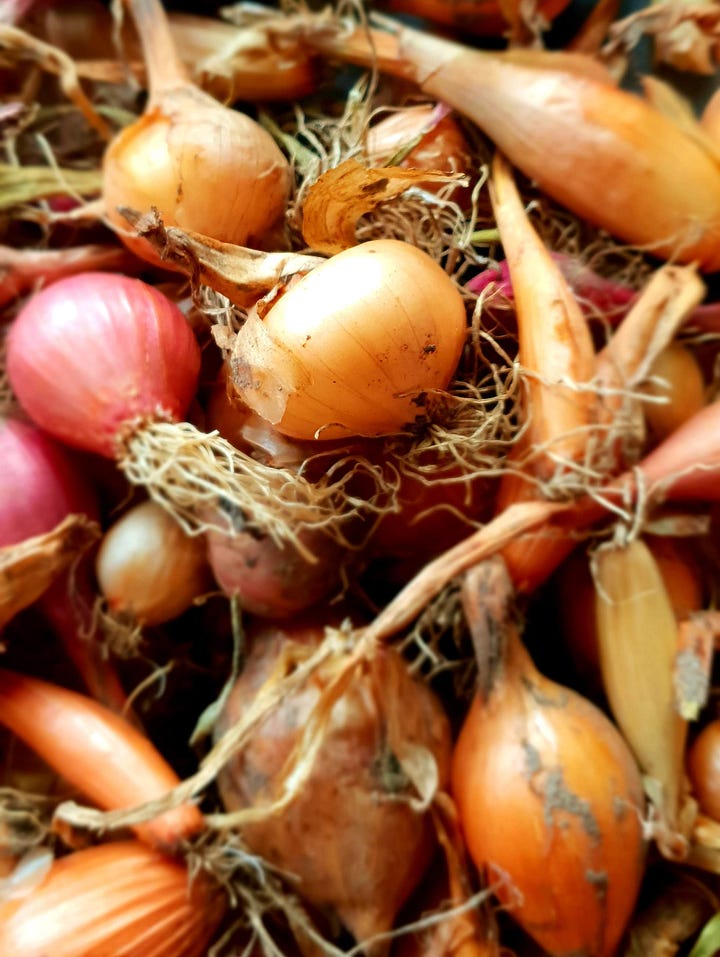
Shallots
Shallots are a delicacy. Their flavor is more subdued and complex than onions and I wouldn’t want to be without them in the kitchen. They are a must in any kitchen garden, if good shallots aren’t easily found or affordable in your region. Some varieties are round, others are elongated. The outer layers are usually pink.
Botanical studies are on-going to definitely differentiate between shallots and onions; currently, shallots are called Allium cepa var. Aggregatum or Allium ascalonicum. Sometimes Latin isn’t the lingua franca! The word aggregatum refers to an important characteristic: shallots split in their second year, similar to garlic. (Some varieties of onions do, too, however.) Shallot sets will result in a cluster of several new shallots (vegetative), but they can also be grown from seed. Individual bulbs will develop in the first year, which then split in the second year. As with bulbing onions and leeks, starting transplants in February is recommended.
Good to know: The ‘French Grey’ shallot is its own variety (Allium cepa var. Sylvestre), also known as Allium oschaninii in Europe. The name comes from its grey skin; its flavor is sharp and sweet. The French differentiate between éschalottes and échalion: Échalion does not belong to aggregatum; these varieties reproduce themselves exclusively via seeds (not splitting).
Sowing: Same as bulbing onions.
Spacing: Spacing depends on type. ’Echalion‘ types via seed should be given spacing of 5-7 cm / 2-3 in. This is also true of shallots grown via seed. A set, on the other hand, will divide itself into several new bulbs and should be spaced 10-15 cm / 4-6 in. apart.
Leeks
Whether short and fat or tall and thin, leeks (Allium ampeloprasum) are easy to grow from seed. I start them in February, which is also recommended for varieties for summer or fall harvest. Other varieties are considered to be more winter-hardy and can be harvested throughout the winter. These can be started in March or April. I prefer to start leeks as seedlings. A late sowing around June 21st, the summer solstice, will develop into baby leeks just in time for Christmas.
Good to know: Although gourmets prefer the blanched white part of the leek for cooking, I often use the whole plant in soups, quiche and other dishes. If not, the leaves can be dried and used to flavor soups.
Sowing: Sowing leeks is the same as bunching onions (see above).
Spacing: Like bulbing onions, the recommended spacing is 10 cm / 6 in. I plant them in groups of three. To maximize the blanched part of the plant, leeks are traditionally hilled, similar to potatoes. I plant seedlings as deep as possible using a drill; the green tips of the seedlings are just above the soil level.
I am honored to grow seed saved by a French friend’s family for six generations. I’ve called it ‘Perón‘ after Maryline’ family at Ferme de Keraugant in Brittany (on Instagram here). The seeds have an astounding genetic diversity, so no two are alike. Some bloom purple, others white, and occassionally I have seed heads that produce bulbils - little baby plants - rather than seeds. I put these in a pot and let them grow on, then separate them when transplanting.


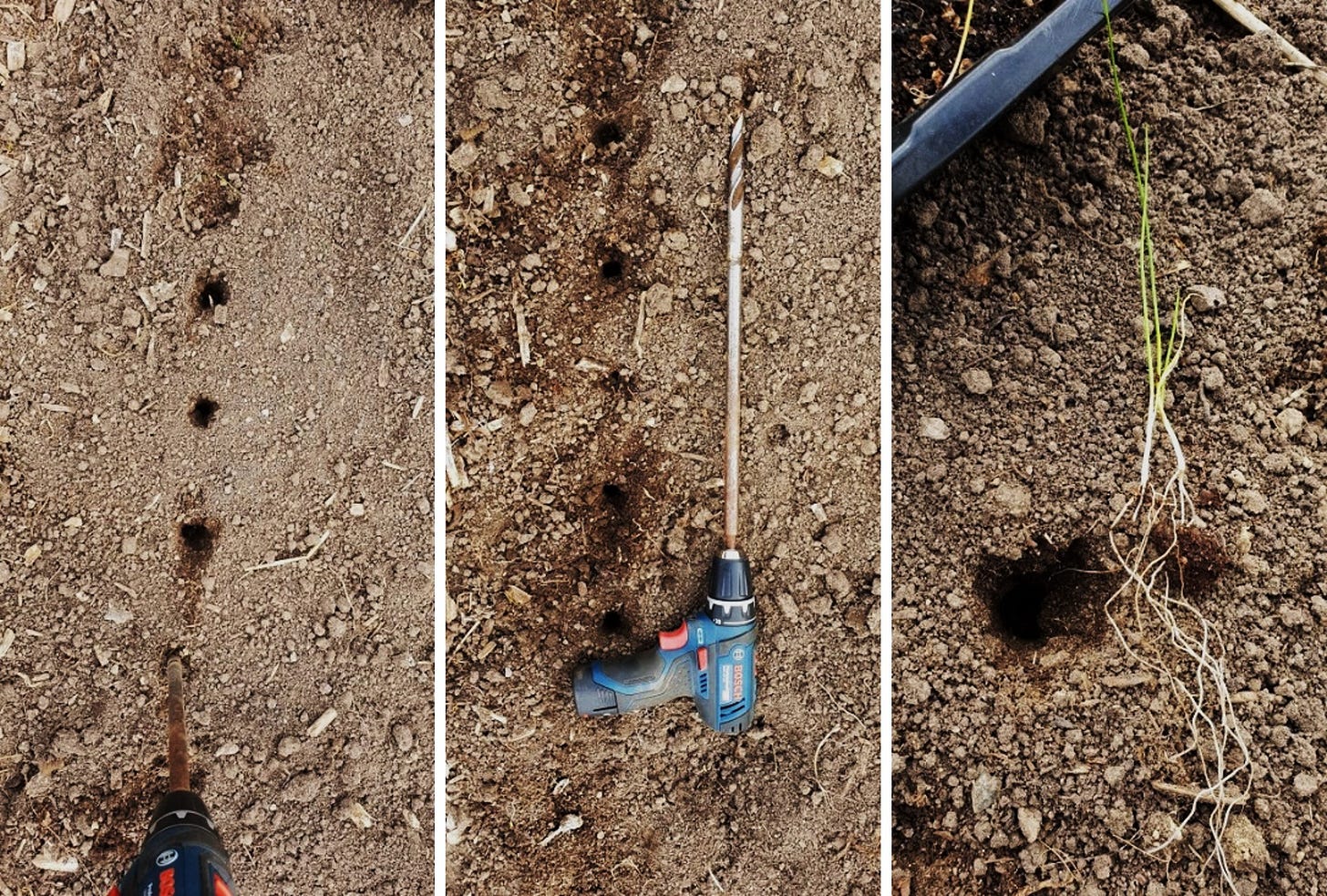
Garlic
Garlic (Allium sativum) is used both for its culinary value as well as its healing properties. A life without garlic is unimaginable. It is propagated by cloves, which are planted in late fall. Like shallots, the cloves swell and then split, forming the clove we use in the kitchen. Soft-neck types develop a stem which develops a head of bulbils. While these tiny bulbs are also edible, it is the scapes (the young stems), which emerge in June that are a culinary delight. I consider it a multipurpose veg because of them. “Round garlic” is the first year of a bulbil, which I also plant. Although I harvest scapes carefully, I always miss a few and end up with a head of bulbils.
Garlic, like onions, should be cured in a warm, dry location with good air circulation, before being stored. Hard neck types develop robust leaves that, when dried, can be braided - a beautiful way to store garlic.
Black garlic is a culinary specialty, not a variety. It is made by keeping the garlich cloves at 60º C for 3-4 weeks. The creamy white flesh of the cloves turns black and a flavor enfolds that is hard to describe. Some say it is like a dark caramel, others say they are reminded of balsamico or melasses.
Good to know: Garlic rarely builds a flower head that results in flower seeds. Because of this, it is a veg type that is mainly propagated by clones (cloves or bulbils) and there are relatively few varieties. Garlic seeds are prized by passionate “True-Seed Garlic“ breeders, who attempt to develop new varieties.
Sowing: Garlic cloves are set with the pointed end facing up at a depth of 5-7 cm / 2-3 in. The tiny bulbils are planted more shallowly at 2 cm / 1 in.
Spacing: Recommended spacing is 15-20 cm / 6-8 in. Garlic likes its space, so if you’re going for large cloves, give it the higher end of the recommendation. Many swear by mulching with straw after planting, as a protection over the winter. I recommend removing that straw in the spring, so the soil can warm up faster. Beware of using straw as it can contain herbicides and pesticides. I prefer to scatter lamb’s lettuce seeds after planting the garlic; it will protect the soil over the winter without infringing on space. Remove it all in spring, though, preferably by hoeing it and leaving it as mulch.
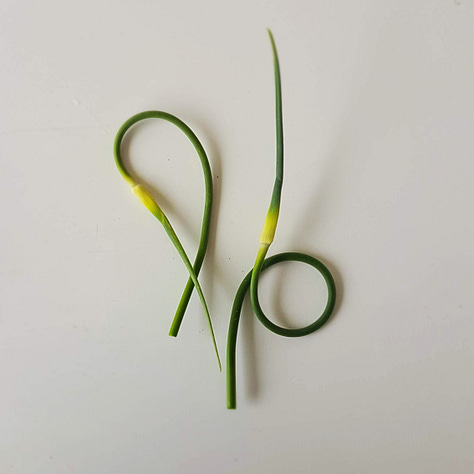

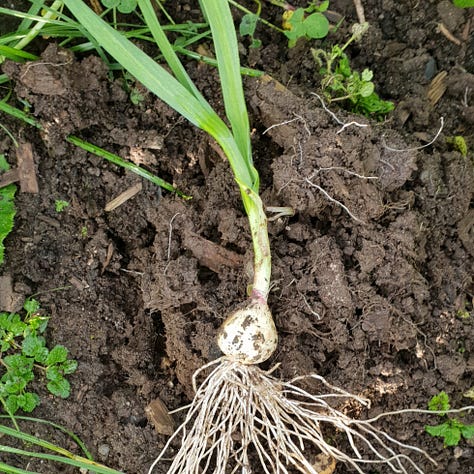
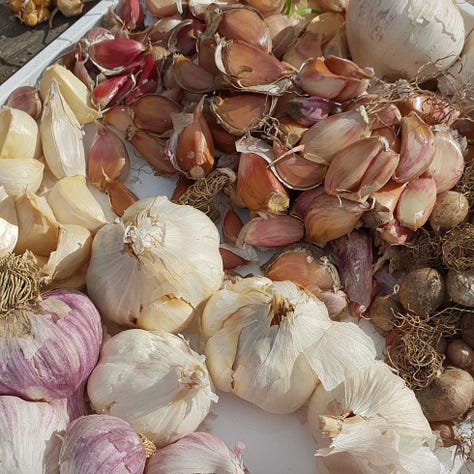

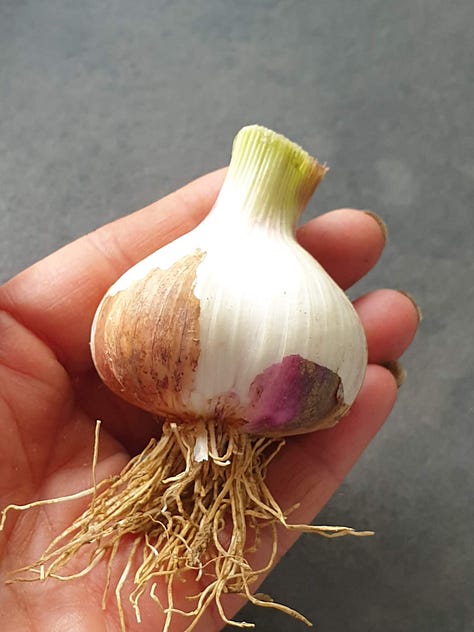
Perennial and wild alliums
Onion aroma:
Chives (Allium schoenoprasum) - Perennial, well-known and much-loved garden herb. The leaves and flowers are used in the kitchen, especially raw as a garnish or in herb spreads. A favorite in Austria is chopped chives on bread and butter. Propagate by division and seeds.
Siberian chives (Allium ledebourianum) - Similar to common chives, but taller and thicker with a much more pungent flavor. Grows in the wetlands of the steppes. Propagate by division and seeds.
Mountain onions (Allium lusitanicum) - A bulb-forming perennial onion found in mountainous regions across Europe, prized for its long banana-shaped bulbs. Propagation is only vegetative, when the main bulb produces side bulbs in spring.
Egyptian onion (Allium viviparum) - A wild species that is also found in home gardens, prized for the pungent bulbils it produces. Often called walking onion because the stems eventually fall tot he ground under the weight of the bulbils, which then root.
Potato onion (Allium cepa L var. aggregatum G. Don) - The potato onion is similar to mountain onions, although it can also bloom and produce seed. Like garlic and shallots, the onion bulb splits in spring to produce new bulbs. Excellent storage onion.
Welsh onion (Allium fistulosum) - Welsh onions are especially winter-hardy and do not die back like other spring onion types, which make them an excellent option for fresh harvest in winter. European varieties tend to have thicker, broader leaves and are pungent. Asian varieties such as ‘Ishikura’ are more delicate and milder. When overwintered, they tend to blossom and produce seed early. Easy to grow with seed.
Garlic aroma:
Wild garlic (Allium ursinum) - A much-loved plant for spring foraging. Wild garlic grows in the forest and propagates itself both vegetatively and via seeds. The wide, dark-green leaves are used for cream soups, pesto and on bread and butter. The flowers are also used in the kitchen as a garnish.
Garlic chives (Allium tuberosum) - Garlic chives are from Asia and are similar to chives, but their leaves are flat and stronger. In summer, the plants bloom and produce seeds. The flavor is intensive but more delicate than regular garlich. Propagate by division and seeds.
Elephant garlic (Allium ampeloprasum L.) - The name comes from the over-sized bulbs that are similar to regular garlic, but the flavor is milder and the garlicky aroma is lost when cooked. Like garlic, cloves can be planted in summer or fall for harvest in the following year.
Sand leek (Allium scorodoprasum) - A wild leek native to Eurasia that is endangered in Europe. Similar to Egyptian onions, it is propagated via bulbils, which in this case are tiny. I was delighted to find it on our field and encourage it, but has generally become rare.
Recipes
Basic pickling brine
I use this basic brine recipe for pickling onions, making capers out of seed pods, and much more. It can be modified by adding fresh herbs, such as dill or rosemary.
Use equal measures of water and vinegar. The vinegar should be a minimum of 4% acidity.
For every cup of liquid, dissolve 1 tablespoon of salt. It helps to heat the brine gently to dissolve the salt.
Example:
1 cup water
1 cup vinegar
2 Tb salt
For a sweet brine, add 1/3 cup / 65 g sugar to two cups of liquid.
Note: 1 cup = 240 ml
Chive Blossom Vinegar
Pack a jar or wide-mouth bottle with chive blossoms, then fill with apple cider vinegar. Allow to steep in a dark place for 1-2 weeks. Strain and bottle.
Thank you for reading! Let me know what was helpful and/or what you would like to know more about!




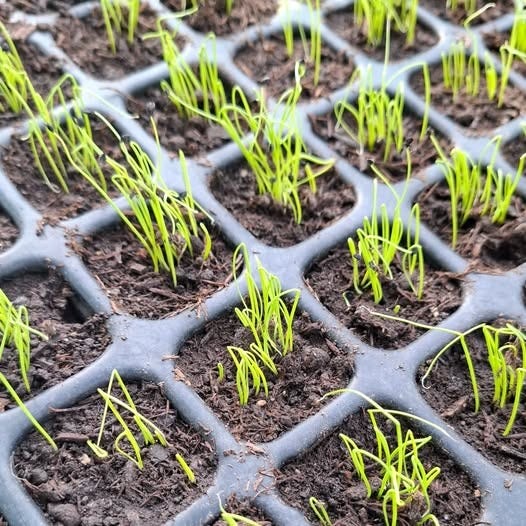

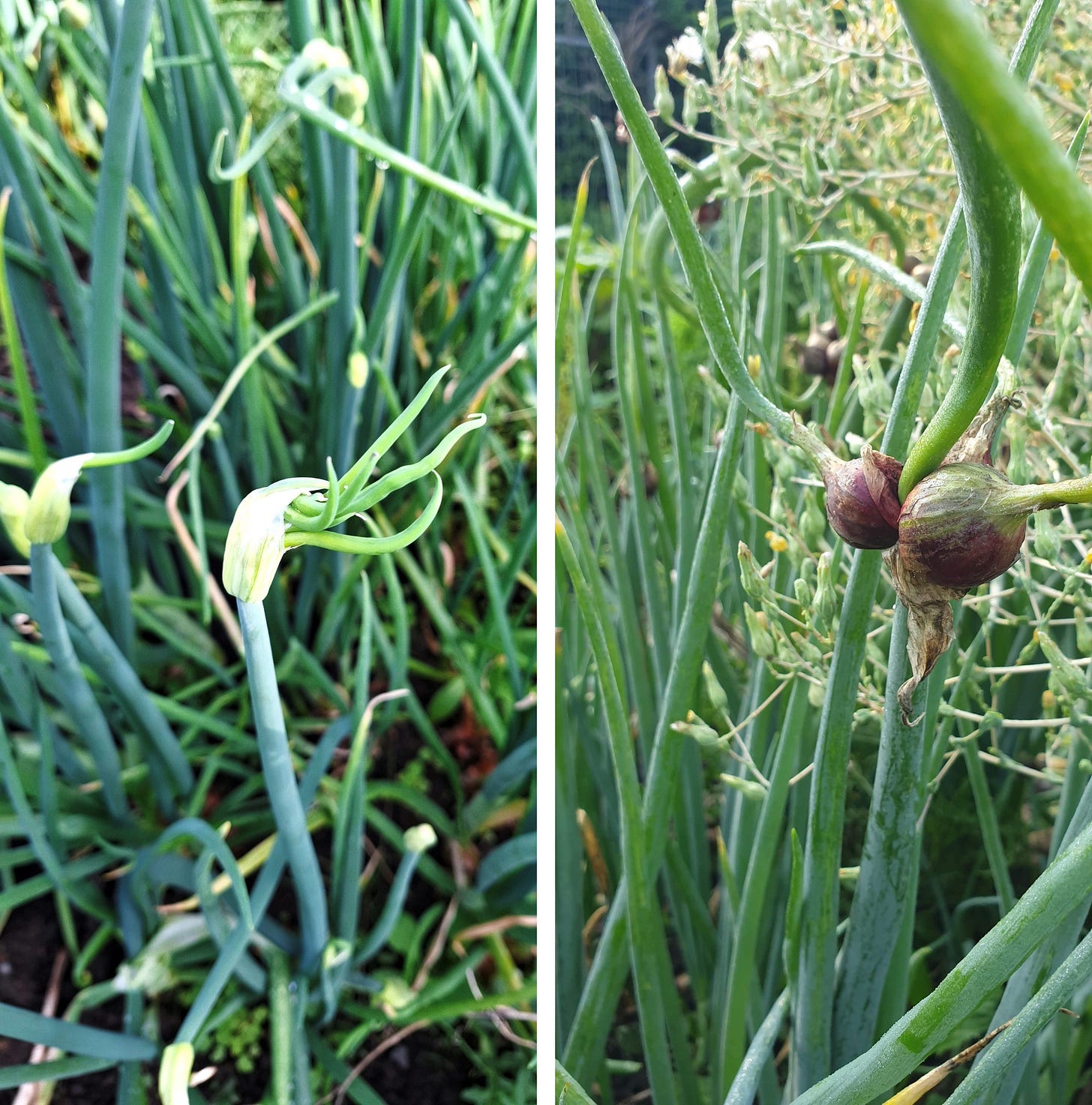
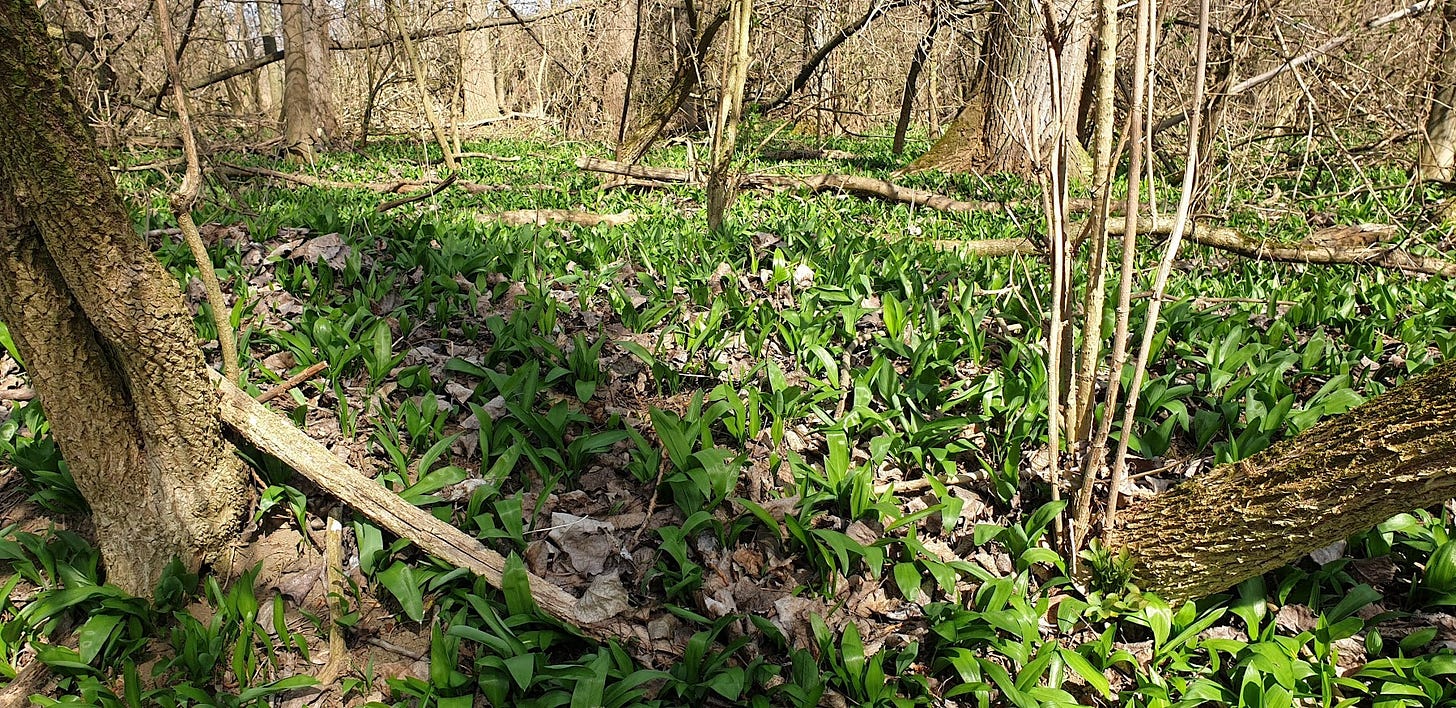

Amazing information and recipes. Thank you for sharing! We are always learning.
I love this article, so interesting this family of Allium - I am also trying to sow some of this ( Allium altaicum, Allium tuberosum, Allium fistulosum etc ) and I'm looking forward!